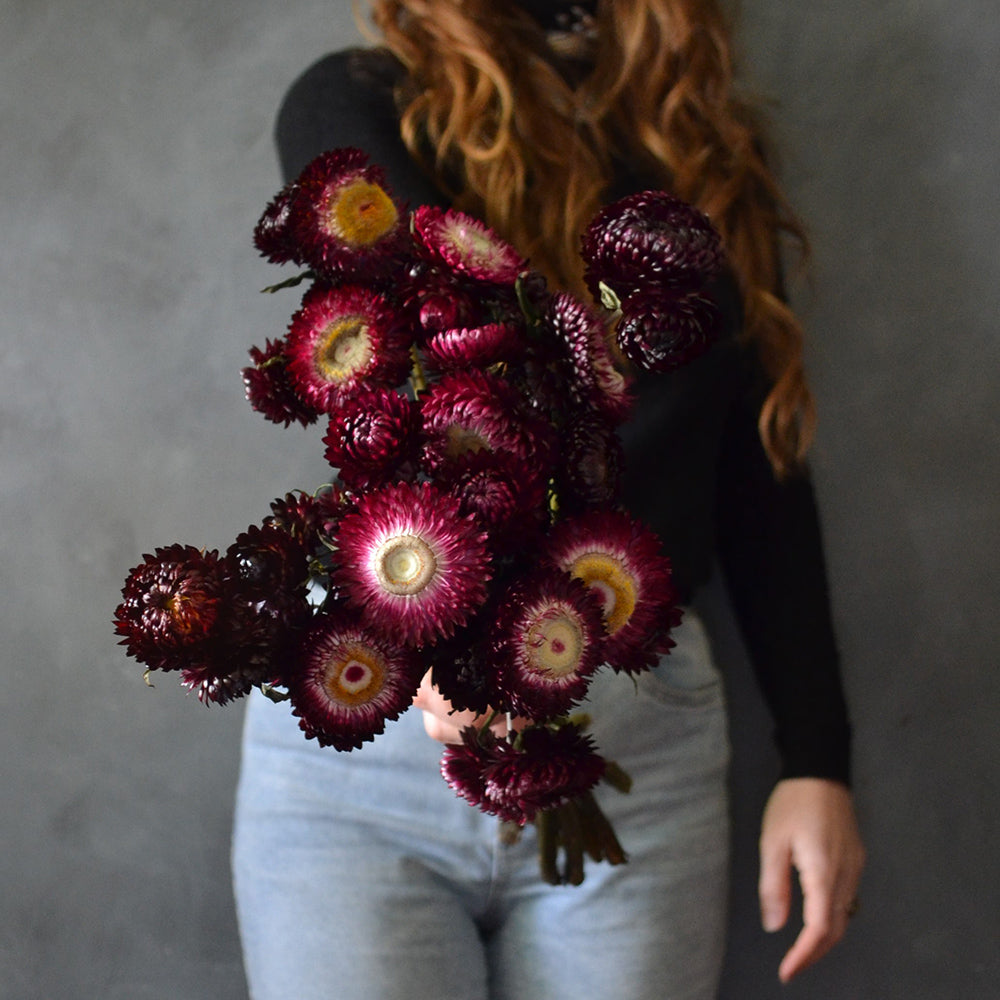Want to know how to dry flowers at home naturally so they retain that gorgeous colour? It’s much easier than you think!
Dried flowers are such a beautiful way to bring a long-lasting touch of nature into your home. Low maintenance, fuss free and naturally beautiful, it’s easy to see why they have had such a big comeback in the last few years.
Along with the resurgence of naturally dried has been the new trend of preserved flowers. Not to be confused with dried flowers, preserved florals are not a natural product anymore. Although they look just like dried flowers, they are so chemically altered that they are no longer biodegradable, and sadly they can only end up in landfill.
COLOURFUL DRIED FLOWERS
The temptation of preserved flowers is definitely their strong, bright colour. But if you, like us, are trying to live in an environmentally friendly way, then naturally dried is definitely the best option.
But how do you get naturally dried flowers and keep their colour?
The answer is simple – choosing the right varieties to begin with! Not all flowers actually dry well. In fact, some can look quite terrible dried, whilst some look absolutely gorgeous. The trick to drying flowers naturally is selecting varieties that will maintain their strong, beautiful colour and original shape even when dry.
No dyes. No chemicals. Nothing fake. Just 100% natural beauty.

SELECTING THE RIGHT FLOWERS
If you are starting out, one of the easiest varieties to dry are paper daisies. Sold in florist shops and in season throughout summer, they are loved by many for their bright colour range of red, pink, orange, yellow, peach, purple and white.
When we first started drying these ourselves we lost many bunches to mould. Here’s what to do to avoid that, and get beautiful, colourful dried paper daisies :
- Strip every single leaf off. Although tedious & time consuming, the leaves are a magnet for moisture and mould. The time it takes to remove all the leaves also lets the stems dry off a little before hanging.
- Keep to bunches of around 10 stems, tie off, and hang so that the bunches are not touching, Air flow is very important.
- Hang in a warm room. This will also help to stop mould from growing and shorten the time it takes to dry them. Around 4 weeks is our average drying time.
As paper daisies are in season in summer, most homes will have the air conditioning running. So a garage or a back shed are the perfect places to dry paper daisies, as they will tend to be warm and well ventilated.
If you are wondering about keeping the colour – that happens naturally! Paper daisies are a wonder as they retain that beautiful colour even when dry. Incredible, right?


HANGING FLOWERS TO DRY
Paper daisies are not the only flowers that dry best by hanging. This method of drying is well suited to types of flowers that would bend or droop during the drying process if they were not hung upside down. Here is a list of flowers that we dry by hanging :
- Statice
- Achillea
- Mulla Mulla (start in a vase first – see below)
- Sanguisorba
- Wheat
- Rhodanthe
- Rice Flower
But not all flowers dry well from being hung up straight away. Some varieties need to stay in a vase of water, drinking and drying slowly. These varieties would collapse or not open fully if they were not allowed to hydrate as they dry. Let’s take a look at these next.
DRYING FLOWERS IN THE VASE
It sounds odd, drying flowers in a vase of water – how can they be “drying” like that? But trust us, for some varieties, this slow method works much better. Here’s why –
For flowers like hydrangea and leeks in particular, if we bought these fresh and took them out of water straight away, the petals would curl and collapse, and the flower would lose its shape. But by leaving them in water and letting them drink, they keep their shape much better.
This is because the natural, slow aging process of the flower is allowed to continue, resulting in a better looking flower that you can keep. We eventually remove the flowers from the water and store them in an empty vase once they are ready. The best way to tell if they are ready to remove is by touching the flower or looking at the stem.
Does the flower feel “dried”? Is the stem yellow or brown? Then it is ready to remove from water and keep in an empty vase. Here are the flowers we use this method on :
- Hydrangea
- Leeks
- Allium ‘drumstick’
- Mulla Mulla – these need to be hung afterwards to straighten out.
- Phylica
- Poppy Pods
- Blushing Bride
- Smokebush
- Possum Banksia
A note on hydrangea – This is a funny flower to dry. If you have ever tried at home you may think it is very hit and miss, and you’d be right! The answer to successfully drying hydrangea is to dry them at the right part of their season.
Never try to dry hydrangea at the start of the season (the start of summer). It will almost always flop on you, even with our method above.
For the best results, dry hydrangea from the end of the season (autumn). The flowers have had time over summer to harden up on the plants, making them a much better candidate for drying. And the absolute best variety for drying is hydrangea paniculata.

DRYING FLOWERS ON THE PLANT
This is the final method of naturally drying, and one that is best suited to seeds and pods. There are many beautiful, textural pods available in autumn after the flowers have set seed, and these can add a wild and rustic look to dried flower arrangements.
You will need to have a good local flower farm or your own flower patch to get some of these varieties, but drying on the plant is the easiest method of all – just let mother nature do its thing! Here are the varieties that we use that were dried on the plant :
- Lunaria
- Nigella
- Scabiosa
- Corokia
- Clematis
- Mountain Daisy
- Fennel
Although not colourful, seeds and pods make fantastic dried bunches. Mixed in with bright paper daisies they create incredible displays, and look fabulous arranged into ceramic vases. There are so many varieties that you can dry naturally – just have a go and see which ones you like!
The beauty of them is that because they are natural, they can always be composted when you want to change your display, which is so much better than having to bin them like you would with preserved flowers.
Other varieties that can keep their natural colour when dried, but that we haven’t tried yet, are gomphrena, delphinium, celosia, larkspur and sea holly. Next time you get a fresh bunch for your home why not try drying it and see what happens!




